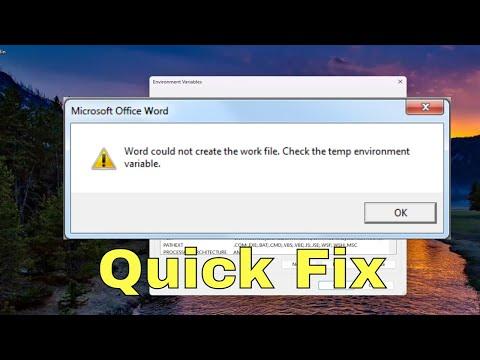It was one of those typical days when everything seemed to be running smoothly. I was working on a crucial report for a major client, and everything was going according to plan. The deadline was looming, and I was determined to finish the project ahead of time. However, just as I was about to finalize the document, Microsoft Word crashed unexpectedly. It was frustrating enough to deal with the sudden loss of my work, but then I saw an error message that made my heart sink: “Word Could Not Create the Work File. Check the Temp Environment Variable.”
At first, I thought it was a minor glitch and tried restarting Word, but the error persisted. I rebooted my computer, hoping it would solve the problem, but to no avail. The same message appeared every time I tried to open or save the document. I started to panic because I had no idea what the error meant or how to fix it. I knew I had to find a solution quickly because I couldn’t afford any more delays.
I began my search for answers online. The error message seemed to indicate an issue with temporary files or the environment variables on my computer, but I wasn’t entirely sure what that meant. I stumbled across several technical forums and support pages, but they were filled with jargon and seemed overwhelming. Determined to fix the issue myself, I decided to break down the problem step-by-step.
The first thing I learned was that the error usually occurs when Word is unable to create or access the temporary files it needs to function properly. These temporary files are essential for Word to perform various tasks like opening, editing, and saving documents. If there’s a problem with the location where these temporary files are stored, Word will throw up this error message.
One common cause of this issue is a misconfigured environment variable, specifically the TEMP or TMP variable, which dictates where temporary files are stored. If the path specified in these variables is incorrect or inaccessible, Word won’t be able to create the necessary files and will throw the error.
Armed with this new knowledge, I decided to check and, if necessary, correct the TEMP and TMP environment variables on my computer. I navigated to the Control Panel and searched for “Environment Variables.” I clicked on “Edit the system environment variables” and then on the “Environment Variables” button in the System Properties window.
In the Environment Variables window, I looked under the “User variables” section for the TEMP and TMP variables. To my relief, they were set to standard locations like %USERPROFILE%\AppData\Local\Temp. I checked these directories in File Explorer to ensure they existed and were accessible. Everything seemed to be in order there, so I moved on to the “System variables” section.
I also checked the system-wide TEMP and TMP variables. They pointed to similar directories, and again, the folders were present and accessible. It seemed like the environment variables were correctly configured. This made me wonder if there was something else causing the issue.
I decided to take a closer look at the folder permissions. Sometimes, the problem isn’t with the environment variables themselves but with the permissions set for the temporary files’ storage location. I right-clicked on the Temp folder and selected “Properties,” then went to the “Security” tab. I checked the permissions for the folder and ensured that my user account had full control. Everything appeared to be fine.
Next, I considered whether there might be a conflict with antivirus software or other security settings. Occasionally, these programs can block access to necessary directories or files. I temporarily disabled my antivirus software and tried to open Word again, but the error message persisted. This step confirmed that the antivirus wasn’t the issue.
After exhausting these possibilities, I decided to try a more hands-on approach: resetting the environment variables to default values. I went back to the Environment Variables window and manually re-entered the paths for TEMP and TMP, ensuring they pointed to %USERPROFILE%\AppData\Local\Temp. I applied the changes and restarted my computer.
Upon rebooting, I opened Microsoft Word with cautious optimism. To my great relief, the error message was gone, and Word was functioning normally again. I was able to open my document and save it without any issues. It felt like a huge weight had been lifted off my shoulders.
In the end, resolving the “Word Could Not Create the Work File” error was a matter of carefully checking and adjusting the TEMP environment variables and ensuring proper folder permissions. The process was time-consuming and a bit nerve-wracking, but it taught me a lot about how my computer manages temporary files and environment variables. Now, when I encounter similar issues in the future, I’ll be more prepared to tackle them.
